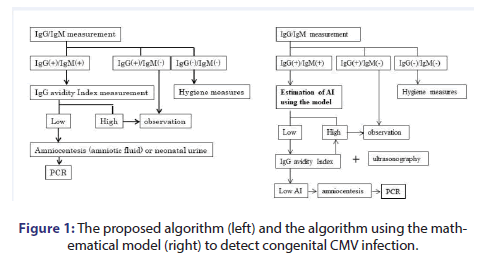The Estimation of a Cytomegalovirus Immunoglobulin G Avidity Using the Mathematical Model
Received: 02-Feb-2022, Manuscript No. Jbclinphar-22-54065; Editor assigned: 07-Feb-2022, Pre QC No. Jbclinphar-22-54065 (PQ); Reviewed: 21-Feb-2022 QC No. Jbclinphar-22-54065; Revised: 24-Feb-2022, Manuscript No. Jbclinphar-22-54065 (R); Published: 03-Mar-2022, DOI: 10.37532/0976-0113.13(1).127
Citation: Kaneko M. The Estimation of a Cytomegalovirus Immunoglobulin G Avidity Using the Mathematical Model. J Basic Clin Pharma.2022;13:127.
This open-access article is distributed under the terms of the Creative Commons Attribution Non-Commercial License (CC BY-NC) (http://creativecommons.org/licenses/by-nc/4.0/), which permits reuse, distribution and reproduction of the article, provided that the original work is properly cited and the reuse is restricted to noncommercial purposes. For commercial reuse, contact reprints@jbclinpharm.org
Description
Human cytomegalovirus (CMV) is the most common virus that causes morbidity and mortality in congenitally infected foetuses and newborns resulting in a broad range of disabilities, including sensorineural hearing loss, visual impairment, and motor and cognitive deficits. However, no global consensus has been reached regarding maternal serum screening for CMV infection. Because, no screening protocols for detecting congenital infection and no effective measures for intrauterine treatment have been established, and no vaccine has been developed to protect against the infection. Conversely, maternal serum screening is considered to be useful for identifying seronegative women and advising them on preventive measures.
Maternal serum screening may increase the rate of unnecessary abortion due to an inadequate maternal support system, as pregnant women fear the risk of vertical transmission and its sequelae. Screening may also cause an excessive number of amniocentesis procedures to be performed and increase the risk of spontaneous abortion beyond the risk of intrauterine CMV transmission. IgG avidity assay testing is an important step within the diagnostic algorithm to assess congenital CMV infection following maternal serum screening (Figure 1). CMV IgM antibodies are present during primary and non-primary infections. Accordingly, IgG avidity assay can help distinguish primary from non- primary CMV infection in pregnant women that are IgM positive.
However, the IgG avidity have some limitations, i.e., the timing of the assay execution influence the IgG AI, the kinetic of IgG avidity maturation in primary infected pregnant women show different patterns according to duration and intensity, Concern about the standardization of various assays remains. Additionally, pregnant women that test CMV IgM-positive exhibit continuous severe anxiety until receiving the result of IgG avidity. Despite the low possibility of foetal infection, many pregnant women with IgM-positive experience severe anxiety during sequential tests. This may place pregnant women in an unfavourable situation concerning their mental health. Recently, we established a mathematical model for predicting high CMV IgG AI using clinical information [1]. The step of the establishment of this model was as follows. First, three hundred and seventy-one women were divided into the high or low IgG AI groups based on the IgG AI cut-off value of 31.75 calculated based on a receiver operating characteristic curve analysis. Second, between-group differences were assessed using the Mann–Whitney U-test or χ2 analysis. As a result, there were significant differences in 5 predictive factors between the high IgG AI and the low IgG AI group (Table 1). Finally, these 5 factors were entered into the multivariate model, and two predictive factors, the CMV IgM titer and women with one parity, were found to be independent predictive factors for a high IgG AI (Table 2). This result helped establish the following mathematical model: score=2.989+(-0.513× CMV IgM titer)+0.625×([0 or 1], 1 for the presence of pregnant women with one parity, 0 for the absence of pregnant women with one parity), Probability =1/(1+exp (-1×score). Pregnant women were classified as having a high IgG AI if the probability was > 0.5. The diagnostic algorithm using this model to assess congenital CMV infection is shown in Figure 1. In conclusion, this mathematical model is extremely accurate ( 97%) in predicting high IgG AI which allows us to reassure pregnant women that we have identified as low risk with a high degree of confidence, immediately after being tested as IgM-positive.
| CMV IgG acidity index | |||
|---|---|---|---|
| Low | High | P value | |
| Age (years) | 28.4 ± 4.7 | 29.9 ± 4.7 | 0. 25 |
| Childcare staff | 4 (6.5%) | 19 (6.1%) | 1 |
| Pregnant women with one parity | 31 (50%) | 104 (33.7%) | <0.01 |
| Maternal fever or flu-like symptoms | 12 (19.4%) | 21(6.8%) | <0.01 |
| CMV IgG | 11.7 ± 9.6 | 20.6 ± 23.0 | <0.01 |
| CMV lgM | 4.7 ± 2.6 | 2.6 ± 1.4 | <0.01 |
| CMV lgG acidity index | 19.4 ± 9.3 | 60.1 ± 14.5 | <0.01 |
| Gestational age at screening (weeks) | 11.8 ± 1.6 | 11.5 ± 1.6 | 0.183 |
Table 1 : The comparison between the low and high CMV IgG avidity index groups1.
| 95% CI | |||||
|---|---|---|---|---|---|
| Variables | B | P value | OR | Low | Upper |
| CMV IgM | -0.513 | 0.000 | 0.598 | 0.513 | 0.699 |
| Pregnant Women with one parity | 0.625 | 0.044 | 1.868 | 1.016 | 3.434 |
| Constant | 2.989 | 0.000 | |||
Note: OR: Odd Ratio, CI: Confidential Interval
Table 2 : Results of multivariable logistic regression analysis of the predictive factors for IgG AI1.
REFERENCES
Kaneko M, Ohhashi M, Fujii Y, et al. A multiple regression model for predicting a high cytomegalovirus immunoglobulin G avidity level in pregnant women with IgM positivity. IJID. 2020;100:1-6.
[Cross Ref] [Google Scholar] [PubMed]


